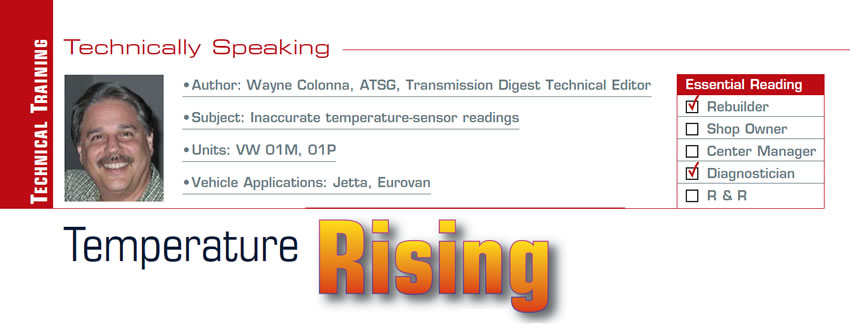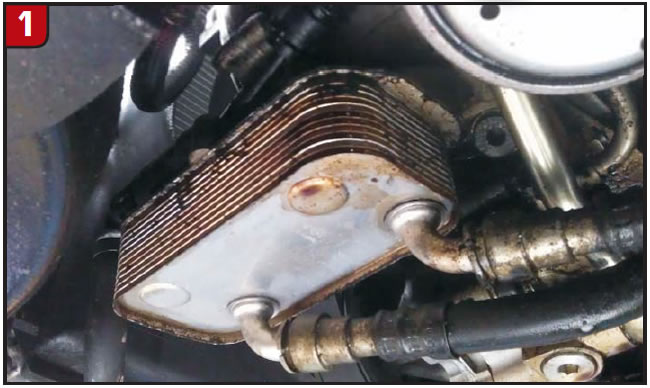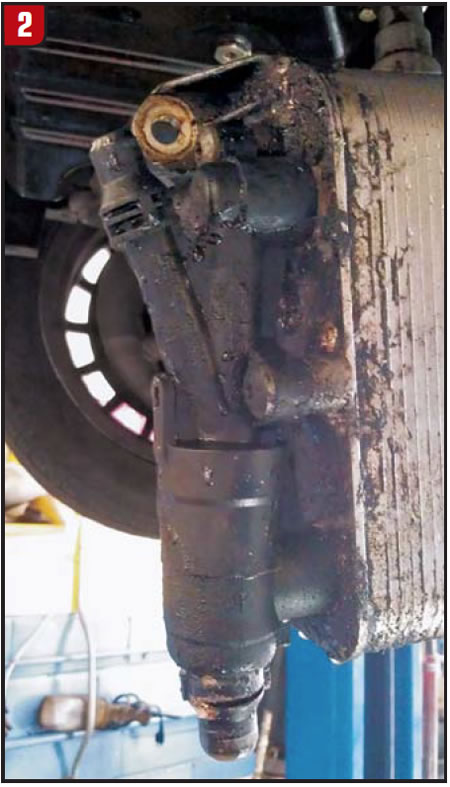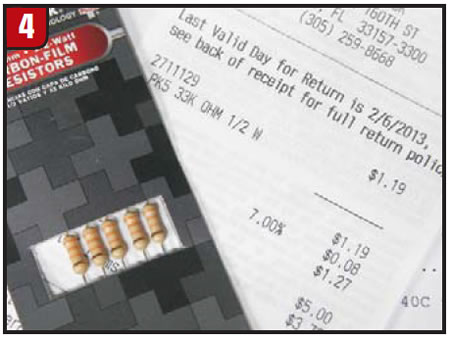
Technically Speaking
- Subject: Inaccurate temperature-sensor readings
- Units: VW 01M, 01P
- Vehicle Applications: Jetta, Eurovan
- Essential Reading: Rebuilder, Diagnostician
- Author: Wayne Colonna, ATSG, Transmission Digest Technical Editor
Temperature rising could be a title for an article related to “global warming,” but this article is not about melting snow caps. This is about a temperature meltdown that can happen to a shop owner and/or technician dealing with a transmission problem that will not go away – specifically with a 01M in a 2001-03 VW Jetta or a 01P in a Eurovan.
The transmission-fluid-temperature sensor is often overlooked yet has a significant influence in pressure control and shift scheduling. When the sensor and temperatures are within normal operating ranges from cold to hot, the transmission will shift at the proper speeds and feel accordingly. But when either the sensor or the actual temperature fails to be within preprogrammed specifications a variety of shift complaints can occur.
Some vehicles, such as the 2003-2004 Range Rover, have an over-heat temperature strategy that initiates when the TCM sees ATF temperature exceed a preprogrammed threshold. Once this strategy is initiated, the driver will notice late shifting and perhaps a sudden neutralizing during highway driving along with a “Transmission Overheat” message appearing in the instrument cluster. The overheat problem in this instance is typically caused by a failed radiator in which the lower eight tubes supplying coolant to the transmission cooler get restricted, preventing heat dissipation.
The over-heat temperature strategy designed to cool the transmission involves significantly increasing the engine speed of the shifting points to maintain optimum engine speed and cooling.
BMW 3 and 5 series have a thermal bypass valve above the heat exchanger (figures 1-3). When this valve fails, causing ATF temperature to increase, a strategy kicks in to extend the shift patterns and prohibit a shift into high (fifth) gear.



But with regard to the early 01M/01P transmission, an unusual problem is known to occur. ATF temperature can reach as high as 140°C (284°F) before the transmission exhibits any malfunctions. As soon as the temperature hits 141°C (285.8°F), erratic, inconsistent, late and flared shifts begin to occur. If you check the transmission-fluid temperature with an infrared temperature gun, it is normal, 48.8-54.4°C (120-130°F). So immediately one would think there is a bad fluid-temperature sensor sending an erroneous signal.
Jack DeBasc from Westside Transmissions in Los Angeles fought with one of these transmissions doing just this. In fact, he has seen two Jettas and one Eurovan with this problem. The first time he tackled this issue he determined that a bad TFT sensor was the problem so he replaced the internal harness. As you might have imagined, he still had the exact same problem, only this time he knew he had a new temperature sensor inside the transmission.

He checked the sensor’s resistance at the transmission-case connector and then again at the TCM connector, and both readings were the same. This suggested that the wiring from the transmission to the computer was good. Since the temperature values in the scan tool are being provided by the computer, the next logical conclusion is a malfunctioning computer. So Jack replaced the TCM and to his disappointment the problem remained. He then went as far as to replace the entire harness from the TCM to the transmission to eliminate any chance of a wiring issue, which also had no effect.
To have new internal and external wiring and a new TCM yet have the TFT parameter identification data (PID) differing from the actual temperature reading implies that there is a software issue in the computer. The resistance-to-temperature lookup table is wrong. Of course, the question is, “Why do we have the problem now?” Why did the original setup work until now, and why with a completely new setup does the problem still exist?
These are all good questions. Having no one able to answer them only enhanced Jack’s problem. So in desperation, Jack went to his local Radio Shack and bought a handful of resistors and inserted each one in series on the signal line to the TCM. He was looking for one that would drop the temperature reading by 10°C (50°F). Of all the resistors he bought, only one came close to his objective, dropping the temperature by 25°C (77°F).
The resistor he used comes in a packet of five (Radio Shack part # 271-1129) costing a total of $1.19 plus tax (Figure 4). This means one resistor cost 24 cents. This 24-cent item fixed his dilemma. And as I mentioned at the beginning of this article, two more vehicles came into Jack’s shop with this problem, and he was able to quickly and inexpensively fix it on both of them.

It is important to note that Jack lives in Los Angeles. For those of you who live in an area with sub-zero temperatures for a part of the year, this fix may cause a new problem when the transmission is cold – unless, of course, you can locate a resistor that can drop the temperature reading by only a few degrees. Once Jack fixed his with a 25°C drop he was finished! Do you blame him?
It was this unpleasant experience that has caused Jack to be extremely aware of temperature-sensor readings and how they affect transmission operation. This awareness helped him to locate the issues BMW 3 and 5 series vehicles have with their thermal bypass valve (figures 1-3). So beware: The problems temperature sensors are able to produce can cause a meltdown in your shop if it’s not a part of your diagnostic thinking process. Even then things can still heat up! By the way, in each of the three situations mentioned in this article – the Land Rover, BMW and VW – the problems began after the vehicle was driven at least 40 minutes or so.














